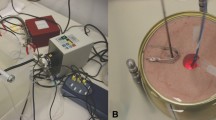Abstract
Diode laser systems at 980 nm have been introduced for the treatment of lower-urinary-tract-symptoms (LUTS) suggestive of benign prostatic enlargement (BPE). However, the coagulation and vaporization properties are unknown. We therefore aimed to evaluate these properties in ex vivo models in comparison with the kalium-titanyl-phosphate-(KTP) laser. The diode laser treatment was applied to isolated, blood-perfused porcine kidneys and fresh human cadaver prostates (HCPs) at different generator settings. We performed histological examination to compare the depth of coagulation and vaporization. The diode laser showed larger ablation and coagulation characteristics than the KTP laser did. Ablation of the diode laser was found to be 1.79-times (120 W in porcine kidney, P < 0.0001) and 3.0–5 times (200 W in HCP, P < 0.0005) larger. The diode laser created a nine-times (120 W in porcine kidney, P < 0.0001) and seven-times (200 W in HCP, P < 0.0001) deeper necrosis zone. The diode laser vaporization was highly effective ex vivo. Owing to the laser’s deep coagulation zones, in vivo animal experiments are mandatory before the diode laser (980 nm) is applied in a clinical setting, so that damage to underlying structures is prevented.







Similar content being viewed by others
References
Costello AJ, Bowsher WG, Bolton DM, Braslis KG, Burt J (1992) Laser ablation of the prostate in patients with benign prostatic hypertrophy. Br J Urol 69:603–608
Malek RS, Barrett DM, Kuntzman RS (1998) High-power potassium-titanyl-phosphate (KTP/532) laser vaporization prostatectomy: 24 hours later. Urology 51:254–256
Te AE, Malloy TR, Stein BS, Ulchaker JC, Nseyo UO, Hai MA, Malek RS (2004) Photoselective vaporization of the prostate for the treatment of benign prostatic hyperplasia: 12-month results from the first United States multicenter prospective trial. J Urol 172:1404–1408
Seitz M, Sroka R, Gratzke C, Schlenker B, Steinbrecher V, Khoder W, Tilki D, Bachmann A, Stief C, Reich O (2007) The diode laser: a novel side-firing approach for laser vaporisation of the human prostate—immediate efficacy and 1-year follow-up. Eur Urol 52:1717–1722
Seitz M, Ackermann A, Gratzke C, Schlenker B, Ruszat R, Bachmann A, Stief C, Reich O, Sroka R (2007) Diode laser: ex vivo studies on vaporization and coagulation characteristics. Urologe A 46:1242–1247
Wendt-Nordahl G, Huckele S, Honeck P, Alken P, Knoll T, Michel MS, Häcker A (2007) 980-nm Diode laser: a novel laser technology for vaporization of the prostate. Eur Urol 52:1723–1728
Kohrmann KU, Back W, Bensemann J, Florian J, Weber A, Kahmann F, Rassweiler J, Alken P (1994) The isolated perfused kidney of the pig: new model to evaluate shock wave-induced lesions. J Endourol 8:105–110
Michel MS, Kohrmann KU, Weber A, Krautschick AW, Alken P (1996) Rotoresect. new technique for resection of the prostate: experimental phase. J Endourol 10:473–478
Reich O, Schneede P, Corvin S, Zaak D, Sroka R, Hofstetter A (2003) Combination of interstitial laser coagulation and transurethral resection of the prostate: ex vivo evaluations. Urology 61:1172–1176
Cooper TE, Trezek GJ (1972) A probe technique for determining the thermal conductivity of tissue. J Heat Transf 94:133
Reich O, Corvin S, Oberneder R, Sroka R, Muschter R, Hofstetter A (2002) In vitro comparison of transurethral vaporization of the prostate (TUVP), resection of the prostate (TURP), and vaporization-resection of the prostate (TUVRP). Urol Res 30:15–20
Madersbacher S, Alivizatos G, Nordling J, Sanz CR, Emberton M, de la Rosette JJ (2004) EAU 2004 guidelines on assessment, therapy and follow-up of men with lower urinary tract symptoms suggestive of benign prostatic obstruction (BPH guidelines). Eur Urol 46:547–554
Kaplan SA (2004) AUA guidelines and their impact on the management of BPH: an update. Rev Urol 6 [Suppl 9]:S46–S52
Reich O, Seitz M, Gratzke C, Schlenker B, Bachmann A, Stief C (2006) Benign prostatic syndrome (BPS). Ablative treatments. Urologe A 45:769–780; quiz 781–762
Gilling PJ, Fraundorfer MR (1998) Holmium laser prostatectomy: a technique in evolution. Curr Opin Urol 8:11–15
Reich O, Bachmann A, Schneede P, Zaak D, Sulser T, Hofstetter A (2004) Experimental comparison of high power (80 W) potassium titanyl phosphate laser vaporization and transurethral resection of the prostate. J Urol 171:2502–2504
Reich O, Bachmann A, Siebels M, Hofstetter A, Stief CG, Sulser T (2005) High power (80 W) potassium-titanyl-phosphate laser vaporization of the prostate in 66 high risk patients. J Urol 173:158–160
Sandhu JS, Ng CK, Gonzalez RR, Kaplan SA, Te AE (2005) Photoselective laser vaporization prostatectomy in men receiving anticoagulants. J Endourol 19:1196–1198
Bachmann A, Schürch L, Ruszat R, Wyler SF, Seifert HH, Müller A, Lehmann K, Sulser T (2005) Photoselective vaporization (PVP) versus transurethral resection of the prostate (TURP): a prospective bi-centre study of perioperative morbidity and early functional outcome. Eur Urol 48:965–971
Wilson LC, Gilling PJ, Williams A, Kennett KM, Frampton CM, Westenberg AM, Fraundorfer MR (2006) A randomised trial comparing holmium laser enucleation versus transurethral resection in the treatment of prostates larger than 40 grams: results at 2 years. Eur Urol 50:569–573
Elzayat EA, Habib EI, Elhilali MM (2005) Holmium laser enucleation of the prostate: a size-independent new “gold standard". Urology 66:108–113
Te AE, Malloy TR, Stein BS, Ulchaker JC, Nseyo UO, Hai MA (2006) Impact of prostate-specific antigen level and prostate volume as predictors of efficacy in photoselective vaporization prostatectomy: analysis and results of an ongoing prospective multicentre study at 3 years. BJU Int 97:1229–1233
Acknowledgement
The authors received no funding and no grants.
Author information
Authors and Affiliations
Corresponding author
Rights and permissions
About this article
Cite this article
Seitz, M., Reich, O., Gratzke, C. et al. High-power diode laser at 980 nm for the treatment of benign prostatic hyperplasia: ex vivo investigations on porcine kidneys and human cadaver prostates. Lasers Med Sci 24, 172–178 (2009). https://doi.org/10.1007/s10103-008-0543-5
Received:
Accepted:
Published:
Issue Date:
DOI: https://doi.org/10.1007/s10103-008-0543-5




